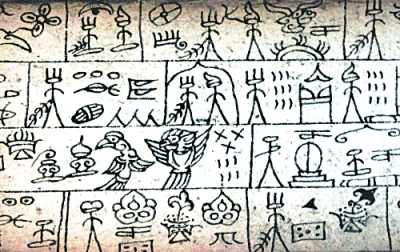Dongba characters: Unique living pictographs

Dongba characters are more similar to Chinese characters than pictures.
Dongba characters, a series of primitive pictographic glyphs, date back to the 11th century. There are more than 2,000 of these characters, which were named after the Dongba priests of the Naxi ethnic minority, who used them to record texts.
From the aspect of structural development, Dongba characters originated earlier than oracle bone inscriptions, which can be considered part of the early stage of character development. They are identified as unique living pictography in the world and a living fossil in the history of characters. Chinese researchers have found a close relationship between Dongba characters and literacy levels.
Compared with pictures, Dongba characters play a significant role in stimulating children’s ability to remember Chinese character forms. Dongba characters share a similar structure with Chinese characters. Dongba characters’ phonological symbols refer to classified radicals, phonetic radicals, or compound characters that lie somewhere between two radicals, which are rather similar to ancient Chinese characters’ phonograms. Moreover, Dongba characters and Chinese characters have similar cognitive characteristics. When Dongba characters are processed, there are a number of factors involved, including the specificity effect, familiarity effect and typicality effect for processing the entire character. In the processing of compound Dongba characters, there exist the radical number effect, classified radical effect and phonetic radical effect to a certain degree.
Dongba characters represent an intermediary stage in which script was transforming from pictograph to ideo-phonograph. So Dongba characters are more similar to Chinese characters than pictures.
